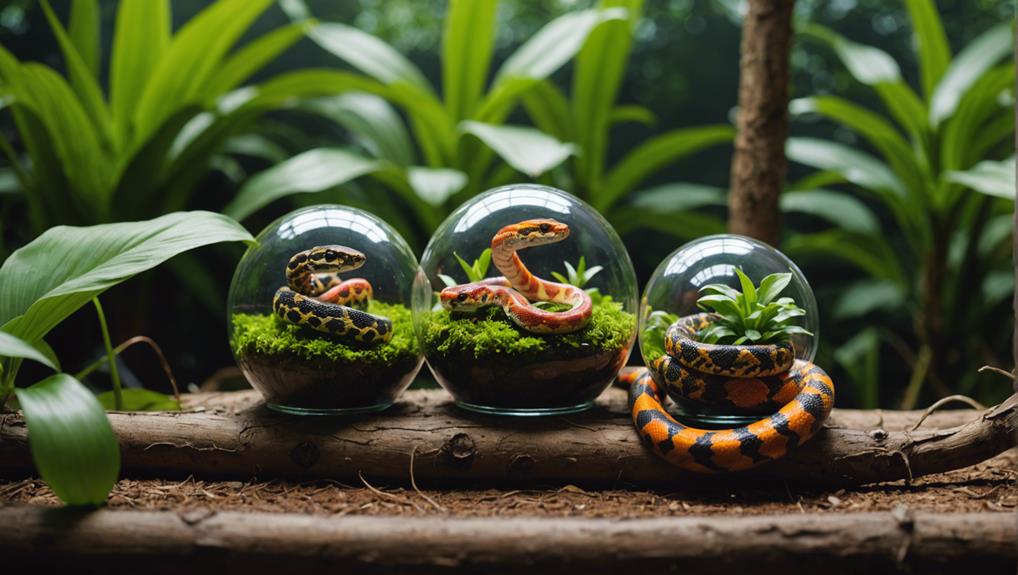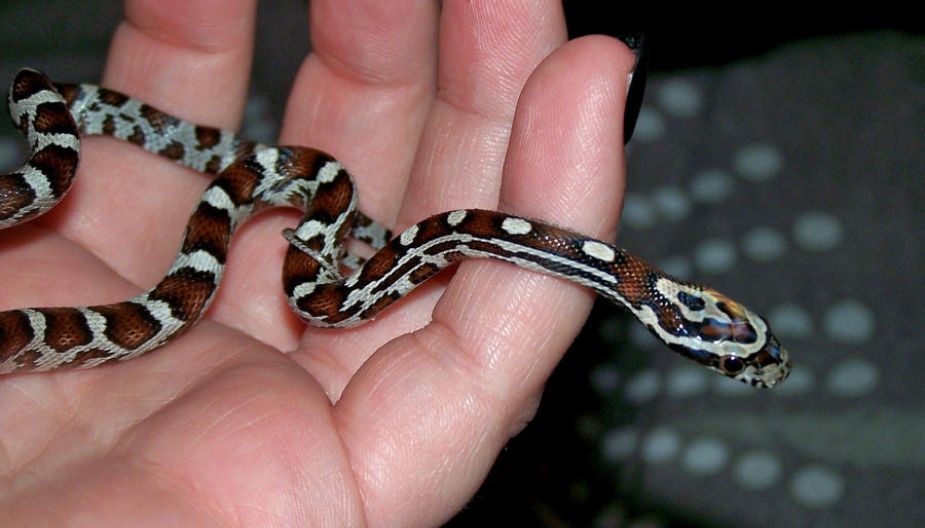Choosing the Perfect Pet Snake: Ball Python or Corn Snake?
When deciding between a Ball Python and a Corn Snake, it's essential to consider their unique characteristics.
Corn Snakes are known for their vibrant colors and active nature, but they can release a strong musky odor when stressed. Ball Pythons, on the other hand, are generally calmer and thicker, but can be picky eaters.
In terms of enclosures, Corn Snakes require less space and simpler ventilation, whereas Ball Pythons need larger, well-ventilated areas.
Both snakes need regular enclosure maintenance to stay healthy, but Corn Snakes are generally hardier.
One key difference is their lifespan: Ball Pythons can live up to 30 years, while Corn Snakes typically live between 20-25 years.
By understanding these differences, you can make an informed decision about which pet snake is right for you.
In this article, we'll explore the pros and cons of Ball Pythons and Corn Snakes, helping you choose the perfect pet snake for a beginner.
Appearance
When comparing ball pythons and corn snakes, their appearances are strikingly distinct, with corn snakes boasting more vibrant colors and patterns.
You'll often notice that corn snakes exhibit a wide range of vibrant oranges, reds, and yellows, making them visually appealing. These color morphs contribute to their popularity among snake enthusiasts.
They also have a slender build, which adds to their unique appearance.
In contrast, ball pythons are typically spotted with browns, yellows, and blacks. While they may not have the same level of vibrancy as corn snakes, their patterns are no less striking.
Ball pythons have a more robust and thicker build compared to the slender corn snakes. This difference in body structure is another distinctive feature that sets them apart.
Additionally, if you're interested in more unusual patterns, ball pythons do come in fancy morphs that showcase a variety of colors and designs beyond their typical palette.
Both species offer a wide variety of patterns and colors, which is why they're popular choices for those who enjoy keeping snakes.
However, the average corn snake tends to be smaller, with an average length of 2-4 feet and a weight of about two pounds.
Ball pythons are generally larger, averaging 3-5 feet in length and five pounds in weight.
Temperament
Both corn snakes and ball pythons are known for their non-aggressive and relaxed nature, making them ideal pets for snake enthusiasts.
If you're looking for a calm and docile companion, the ball python might be your best bet. These snakes are incredibly laid back and often enjoy curling up in your lap, which makes them perfect for handling. Their temperament is typically very calm, and they're unlikely to react aggressively, provided they've been properly socialized from a young age.
On the other hand, corn snakes are also quite docile but have a more active temperament compared to ball pythons. When you handle a corn snake, you'll notice that they prefer to move around and explore their surroundings rather than sitting still. This active behavior can be quite entertaining but might require a bit more attention and care to prevent them from slipping away.
While they're generally non-aggressive, corn snakes occasionally exhibit musking—a defense mechanism that releases a foul odor when they feel threatened. However, this behavior tends to diminish as they become more comfortable and accustomed to their environment.
Both species are tolerant of human contact if they're socialized properly from a young age. This means you can interact with them regularly without much worry. Ball pythons, with their laid back demeanor, are often easier to handle for beginners who might be nervous about handling a snake.
Corn snakes, being more active, may require a bit more vigilance but offer an engaging and dynamic pet experience. Ultimately, both snakes can make wonderful pets, provided you're prepared to meet their respective needs.
Feeding
Feeding your ball python or corn snake requires understanding their unique dietary preferences and feeding schedules.
Corn snakes are less picky eaters and more forgiving of husbandry mistakes. They generally eat like clockwork and readily accept frozen/thawed food. This makes them an excellent choice if you're looking for ease and consistency in feeding. Corn snakes can be fed every 7-14 days, and they'll typically accept pre-killed prey without much fuss.
On the other hand, ball pythons can be finicky eaters. They may go off food for a while, requiring more advanced feeding techniques and a varied diet to keep them interested. Ball pythons need a precise feeding schedule, with adults typically eating every 7-10 days. Their preference often leans towards live or freshly killed prey, which can make feeding more challenging.
When feeding either species, it's crucial to ensure that you're offering an appropriate diet and sticking to a regular feeding schedule. Both snakes require frozen/thawed food, but you'll find that corn snakes are more likely to accept it without hesitation. Ball pythons, however, might need a bit more coaxing, sometimes preferring live prey.
If you choose to offer live prey, always supervise the feeding to prevent any injuries to your snake.
Enclosure Requirements
After guaranteeing your ball python or corn snake is well-fed, it's important to provide the right enclosure to keep them healthy and comfortable. Let's explore the specifics for each species.
For a ball python, you'll need a larger enclosure, with a minimum tank size of 30-40 gallons for adults. Corn snakes, on the other hand, can thrive in slightly smaller tanks, ranging from 20-30 gallons.
The substrate is another key factor. Ball pythons require a deeper substrate of 2-3 inches to accommodate their burrowing behavior, while corn snakes are comfortable with a 1-2 inch depth.
Ventilation is vital. Ball pythons need a more advanced ventilation system due to their larger size and higher humidity requirements. In contrast, corn snakes can do well with a simpler ventilation system.
Maintaining the right temperature gradient is also essential. For corn snakes, confirm the enclosure has a gradient of 75-82°F on the cool side and 80-85°F on the warm side. Ball pythons need a slightly different range, with 75-80°F on the cool side and 88-92°F on the warm side.
Humidity levels differ too. Ball pythons prefer higher humidity, which can be managed with appropriate ventilation and a humidity-retaining substrate. Corn snakes don't need as much humidity, making them easier to care for in this aspect.
Both species require hiding places to feel secure, but ball pythons may need more due to their larger size and potential for stress.
Lastly, a heat lamp is essential to maintain the proper temperature gradient in the enclosure.
Health and Lifespan
Ensuring the health and longevity of your ball python or corn snake involves understanding their specific needs and potential health issues. Ball pythons can live up to 30 years, while corn snakes typically live for 20-25 years, so you're committing to a long time with either pet.
Ball pythons are prone to certain health issues such as Upper Respiratory Infections (URIs), which can be exacerbated by incorrect humidity levels. They may also face problems shedding, requiring you to monitor their environment closely.
On the other hand, corn snakes are generally hardier and more forgiving of husbandry mistakes, making them a better choice for beginners. However, corn snakes can musk, a defense mechanism that expels a foul smell when they feel threatened.
Both species can suffer from common health problems like mouth rot, dermatitis, and respiratory diseases, but these can be prevented with proper care and maintenance. Ensuring a captive bred snake can also reduce the risk of initial health issues.
Regular cleaning and maintenance of the enclosure are essential, as is providing a balanced diet and proper humidity and temperature control.
A ball python's need for specific humidity levels means you'll need to be diligent in maintaining their environment. Corn snakes are less demanding in this regard, but they still require a clean and stable habitat.
Conclusion
Choosing between a ball python and a corn snake depends on what you value in a pet.
Ball pythons are known for their calm nature and manageable size, while corn snakes are active and come in a variety of colors.
Both have straightforward feeding and enclosure needs, but corn snakes generally require less space.
Consider each species' temperament, care requirements, and lifespan to find the best match for you as a beginner reptile owner.


